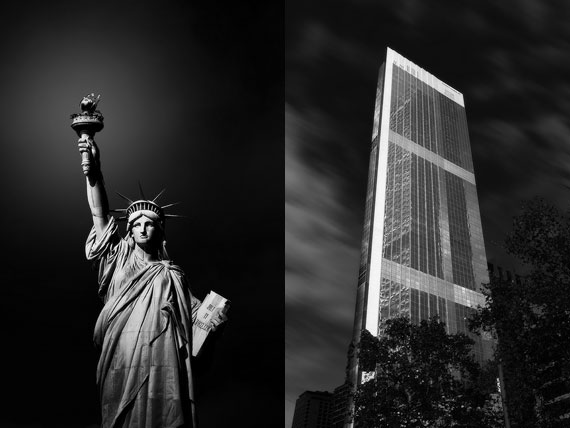Black and white photography can create a world that is stripped down to its most basic elements, allowing for a more abstract and artistic representation of the world.
One key aspect of this type of photography is the use of texture, pattern and lines to create visual interest. These elements can be used in a variety of ways to convey mood, emotions and meaning in a photograph.

Texture:
Texture refers to the surface quality of an object in a photograph, and it can be used to create a sense of depth and dimension in black and white.
Textured objects, such as rocks, tree bark, or even fabric, can be used to draw the viewer’s eye into the image and hold their attention.
The play of light and shadow on these textured surfaces can add an extra level of interest to the photograph. In the example above, the textures in the Statue of Liberty’s robe come to life in a way that the original daytime version of this image could not portray.
Pattern:
Patterns are repeating designs that can be found in many aspects of the natural world.
In black and white photography, patterns can be used to create a sense of rhythm and flow within an image. They can also be used to create visual interest by drawing the eye through the image in a specific way. For example, a photograph of a series of waves crashing on the shore can create a pattern that leads the eye from the bottom of the image to the top.
Lines:
Lines are one of the most fundamental elements of design and are used in a variety of ways in black and white photography. Straight lines can create a sense of order and stability, while curved lines can convey a sense of movement and fluidity. Lines can also be used to direct the viewer’s eye to specific parts of an image, and they can help to create a sense of depth and perspective.
Editing:
Editing of course also plays a crucial role in creating visually interesting black and white images.
By finely tuning the tones and contrast of an image to your artistic direction, you can highlight these textures, patterns, and lines in creative ways that just aren’t possible in colour.
Whether you’re a seasoned photographer or just starting out, incorporating all of this into your black and white images can help to take your photography to the next level.
If you’d like to learn more about the creative side of black and white editing, you may want to try Steve’s Creative Black & White Editing Course while it is 40% off:
Creating great-looking B&W images is about more than just removing color via “desaturate”, or moving a few sliders up and down with a black and white adjustment layer. Landscape photographer Steve Arnold created this course to help photographers master the critical concepts. We were able to arrange a 40% discount for PictureCorrect readers for a limited time if you want to check it out.
Deal ending soon: The Creative Black & White Editing Course at 40% Off
- - - - - - - - - - - - - - - - - - - - - - - - - - - - - - - - - - - - - - - - - - - - - - - - - - - - - - - - - - - - - - - - - - - - - - - - - -
Did you appreciate this newsletter? Please help us keep it going by Joining Our Patreon Supporters
What are your thoughts on this article? Join the discussion on our Facebook Page
PictureCorrect subscribers can also learn more today with our #1 bestseller: The Photography Tutorial eBook
- - - - - - - - - - - - - - - - - - - - - - - - - - - - - - - - - - - - - - - - - - - - - - - - - - - - - - - - - - - - - - - - - - - - - - - - - -
The post How to Bring Your Black and White Images to Life appeared first on PictureCorrect.
from PictureCorrect https://ift.tt/nk36tdJ
via IFTTT







0 kommenttia:
Lähetä kommentti